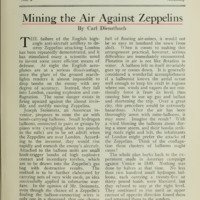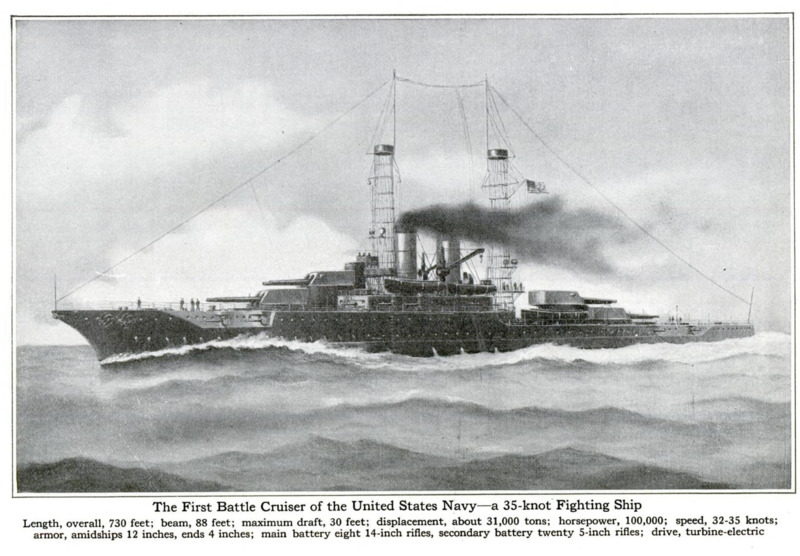America's First Thirty-Five Knot Battle-Cruiser
Item
-
Title (Dublin Core)
-
America's First Thirty-Five Knot Battle-Cruiser
-
Article Title and/or Image Caption (Dublin Core)
-
America's First Thirty-Five Knot Battle-Cruiser
-
extracted text (Extract Text)
-
COMMON sense teaches everyone
that speed, range, striking power
and adequate armor protection,
are essential in a fighting vessel and
the ship in which these are combined
to a preeminent degree most fully
meets the ideal. But it is no easy
matter to unite all these attributes in a
single craft of a given tonnage. If a
battleship is excessively armored, weight
must be saved elsewhere—in guns, en-
gines, etc. And so it happens that every
fighting ship is more or less a compro-
mise effected by the advocate of speed
with the advocate of heavy guns and
thick armor.
Although the developments in battle-
ship construction have been exceedingly
rapid, the greatest impetus was given
about ten years ago when Great Britain
came to the fore with the Dreadnought,
a ship which mounted only big guns.
namely ten twelve-inch rifles. She was
fast too, for her speed was twenty-one
and one-half knots, something unprece-
dented in battleships.
Soon the superdreadnought appeared,
a vessel still faster, mounting still bigger
guns, and still more heavily armored.
en came the battle cruiser, a formid-
able craft with a speed of twenty-eight
knots—a type also first introduced by
Great Britain.
These battle cruisers—vessels which
‘mount somewhat fewer heavy guns than
the superdreadnought, but of the same
caliber, and which have somewhat lighter
armor and the greatest speed that can be
given to a warship are at last to be intro-
duced in our own navy. If we were to
engage now in a naval war with a foreign
power, we would be hopelessly at a dis-
advantage, not only because of the few-
ness of our superdreadnoughts, but be-
cause we utterly lack battle . cruisers.
While no official announcement has
been made of the principal features of
these new ships, the POPULAR SCIENCE
MoxTHLY is in a position to present de-
tails which may be accepted as accurate.
Profiting by the lessons taught by the
engagements fought off the Falkland
Islands and in the North Sea, this new
battle cruiser of ours is to have a speed
somewhere between thirty-two and thir-
ty-five knots. Obviously engines of
¢normous power are required to attain
that speed, and so we may expect that
one hundred thousand horsepower must
be generated. Every additional knot
means an inordinate increase in engine
capacity.
Our unbuilt and unnamed battle cruiser
will have eight fourteen-inch guns and
twenty five-inch guns. At first blush it
would seem as if the Queen Elizabeth's
fifteen-inch guns must carry the day if
these two ships were ever opposed. But
our ordnance officers have made the state-
ment that the new fourteen-inch guns
which they have developed are the su-
perior of the fifteen-inch guns at present
used in the Dritish navy—or statements
to that effect.
The armor protection of the new
United States battle cruiser is to be
twelve inches amidships and four inches
at the ends. The Queen Elizabeth has
thirteen and one-half inches of steel on
the waterline, ten inches above that and
a top layer of cight and one-quarter
inches. It is here probably that we had
to make our sacrifice in order to gain
the engine power and, therefore, speed.
But if speed will enable our ship to pick
out her own position and our guns have
the greater range, the loss in armor pro-
tection is more than compensated for.
The Lion and Tiger are battle cruisers
in the true sense of the word. Our ship
will easily outdistance them. In tonnage
there is not much to choose, for they
displace thirty thousand tons as against
the thirty-one thousand tons of our ves-
sel. In armament we will be far supe-
rior. The Lion and the Tiger cach mount
eight fourteen-inch guns which are prob-
ably inferior in range to the guns of
equivalent caliber on the proposed Amer-
ican ship. The Tiger has twelve six-
inch guns and the Lion sixteen four-inch
guns; but weapons of such small char-
acter play no part in a long range en-
gagement and are serviceable chiefly for
the repulsion of torpedo boats.
-
Language (Dublin Core)
-
eng
-
Date Issued (Dublin Core)
-
1916-02
-
pages (Bibliographic Ontology)
-
186-187
-
Rights (Dublin Core)
-
Public Domain (Google digitized)
-
Archived by (Dublin Core)
-
Filippo Valle
-
Alberto Bordignon (Supervisor)
 Popular Science Monthly, v. 88, n. 2, 1916
Popular Science Monthly, v. 88, n. 2, 1916



